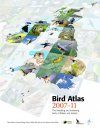Distribution Atlas
Out of Print
By: Mervyn Davies(Author), Peter Eldridge(Author), Chris Robinson(Author), Nick Smith(Author), Gerald Wells(Author)
446 pages, 200 colour photos, b/w illustrations, 348 colour distribution maps, colour tables
![The Birds of Herefordshire 2007-2012 The Birds of Herefordshire 2007-2012]()
Click to have a closer look
About this book
Contents
Biography
Related titles
Recommended titles
About this book
The Birds of Herefordshire 2007-2012 is the first systematic assessment of the breeding and wintering distribution and abundance of the bird species of the county of Herefordshire. It is the culmination of a project, undertaken over a period of ten years, by the Herefordshire Ornithological Club (HOC). The Club, founded in 1950, has carried out many surveys and published annual reports, but never an undertaking as large as a county Bird Atlas.
The opportunity provided by the initiation of the British Trust for Ornithology's ambitious Bird Atlas 2007-11, published in 2013, gave the invaluable stimulus and collaborative framework for HOC to embark on the task. Field work, conducted over the five years 2007-12 amassed a volume of data from a total of 545 tetrads (2-km squares) surveyed across the county. Observations by HOC members and numerous other birders contributed nearly a quarter of a million records to combined BTO and HOC datasets.
The Birds of Herefordshire 2007-2012 presents 215 species accounts and includes 348 distribution and abundance maps with colour plates of many species. Together with supporting chapters, The Birds of Herefordshire 2007-2012 provides a unique benchmark of the current status of the birds of Herefordshire, which will not only expand our understanding but form the basis of future monitoring of the county's bird populations. It will also be of value for research, conservation and, indeed, to all interested bodies working to maintain the well-being of Herefordshire birdlife.
Contents
Foreword
Acknowledgements
Glossary
Standard References
1. The landscape and habitats of Herefordshire
2. Weather and birds, 2007-2012
3. Survey, data analysis and mapping methods
4. Overview of survey results
5. Species accounts
Appendices
References
Index
Customer Reviews
Biography
All authors are members of the Herefordshire Ornithological Society.
Distribution Atlas
Out of Print
By: Mervyn Davies(Author), Peter Eldridge(Author), Chris Robinson(Author), Nick Smith(Author), Gerald Wells(Author)
446 pages, 200 colour photos, b/w illustrations, 348 colour distribution maps, colour tables
"[...] The arrangement is the now conventional double-page spread for most species, with very clear maps of breeding status and of summer and winter abundance, and tables showing population estimates. [...] As there had been no previous atlas for the county, there could be only limited discussion of changes in distribution. [...] In such a large book, it seems unnecessary to devote the top of each page to a huge display of a ‘key’ extract from the text below. This is an echo of a practice in the BTO's own Norfolk Atlas, and most readers will find it an irritant; it adds about a fifth to every recto page. One may note that Liverpool University Press, whose work has been outstanding in the production of local avifaunas, were not themselves responsible for ‘design’ in this book."
– David Ballance, Ibis 157(2), April 2015









































